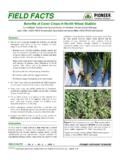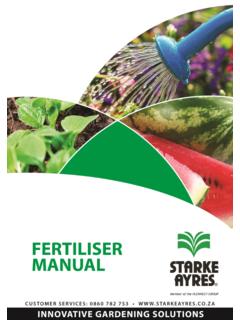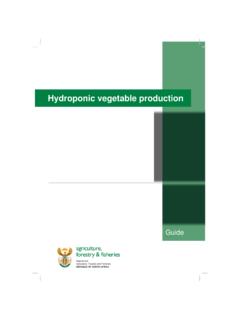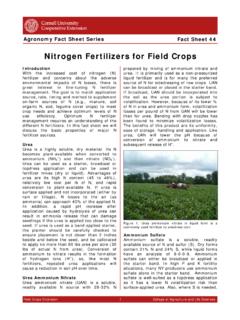Transcription of What is in Fertilizer Other Than Nutrients?
1 WHAT IS IN Fertilizer Other than NUTRIENTS? Raymond C. Ward Ward Laboratories Inc. Kearney, NE Commercial Fertilizer is a source of plant nutrients that can be applied to soil to nourish crops when the soil cannot supply to total crop requirement. Soil testing is the predominant tool to measure plant nutrient levels. When a nutrient in the soil is low a certain amount of that nutrient is recommended to be applied to supply the total needs of the crop and yield. Fertilizer is the normal method of supplying the nutrient although animal manures and sludge may be used. The plant nutrients are inorganic elements. Their plant available forms are: Nitrogen (N) NH4+ and NO3- Phosphorus (P) H2PO4- and HPO42- Potassium (K) K+ Calcium (Ca) Ca2+ Magnesium (Mg) Mg2+ Sulfur (S) SO42- Zinc (Zn) Zn2+ and organic complex Zn Iron (Fe) Fe2+,Fe3+ and organic complex Fe Manganese (Mn) Mn2+ and organic complex Mn Copper (Cu)
2 Cu2+ and organic complex Cu Boron (B) H3BO3 Chlorine (Cl) Cl- Molybdenum (Mo) MoO42- Plants use these ions, sunlight, carbon dioxide, and water to grow. The point of this discussion will show that inorganic fertilizers supply nutrients in the forms used by the plant. Nitrogen Fertilizer manufacturing starts with the production of anhydrous ammonia. Anhydrous ammonia (NH3) is made by combining nitrogen gas obtained from the atmosphere with hydrogen gas obtained from natural gas. It takes 32,000 to 38,000 cubic feet of natural gas to make 1 ton of ammonia. Over 80% of the total cost of manufacturing NH3 is natural gas. The gases are reacted at a temperature of 930 F and 3000 to 4500 psi. The reaction is: N2 + 3H2 2NH3 Phosphorus fertilizers are made from phosphoric acid.
3 Phosphoric acid is made by treating rock phosphate with sulfuric acid. Phosphoric acid and gypsum are produced. There are a few impurities in the acid so the color is green or black. The color does not affect handling of the acid. Almost all potassium fertilizers are obtained from potassium chloride (KCl) ore. It is mined, ground, and suspended in water, treated with a flotation agent that adheres to the KCl crystals. Potash Fertilizer is colored pink to red because of iron that is not removed during processing. I have presented the basics of Fertilizer manufacturing to show the start of making Fertilizer . The main nitrogen Fertilizer is anhydrous ammonia. The main phosphorus Fertilizer is phosphoric acid. Anhydrous ammonia is a base (alkaline) and phosphoric acid is an acid (acid). When an acid and a base are combined a salt is formed. So most Fertilizer products are salts because of this combination.
4 The only prominent exception is anhydrous ammonia. The N, P, and K concentration are expressed as %N, %P2O5, and %K2O, always in this order. This is called a Fertilizer grade. Fertilizer 10-20-10 has 10% N, 20% P2O5, and 10% K2O. Anhydrous ammonia (NH3) is 82% nitrogen and 18% hydrogen. The grade is 82-0-0. Urea Fertilizer is produced by combining anhydrous ammonia and carbon dioxide the chemical formula for urea is CO(NH2)2. Its composition is: Carbon (C) 20% Hydrogen (H) Oxygen (O) Nitrogen (N) A hardener is added to make the granules longer lasting during handling and shipping. Therefore, urea is usually 46-0-0. Ammonium nitrate is made by mixing anhydrous ammonia and nitric acid. The compound formed is NH4NO3. Its composition is: Nitrogen 35% Oxygen 60% Hydrogen 5% The NH4NO3 granule is coated with a clay which retards moisture absorption and caking.
5 This makes the Fertilizer 34-0-0. These are two examples of what is in Fertilizer besides plant nutrients. The compound is formed when you mix an acid and a base. Note that there is no chloride or salt as noted by some. However, the compounds formed are salts. UAN solution is made by combining near equal portions of ammonium nitrate and urea. The solution is 28-0-0 or 32-0-0. The 32-0-0 will salt out near freezing where 28-0-0 can be stored over winter. The properties are: 28-0-0 32-0-0 % Ammonium Nitrate % Urea % Water Phosphorus fertilizers are usually ammonium phosphates but some are calcium phosphate. The ammonium phosphates are produced by reacting phosphoric acid (acid) and anhydrous ammonia (base) to produce monoammonium phosphate (MAP), diammonium phosphate (DAP) and ammonium polyphosphate (liquid).
6 The MAP compound is NH4H2PO4. The composition of the pure compound is: Nitrogen (N) 12% Hydrogen (H) 5% Oxygen (O) 56% Phosphorus (P) 27% Note that the phosphorus concentration is 27% P. However, in Fertilizer P is expressed as P2O5 so P must be multiplied by to convert it to P2O5. The P2O5 concentration in the pure compound would be 62%. The common grade for MAP is 11-52-0. There are some impurities in the phosphoric acid, which lowers the P2O5 to 52%. But the main ingredients of MAP are N, O, P, and H. There is no filler added to lower the grade. The DAP compound is (NH4)2 HPO4. The composition of the pure compound is: Nitrogen (N) 21% Hydrogen (H) 7% Oxygen (O) 49% Phosphorus (P) 23% The P2O5 concentration is 53% with the impurities in the phosphoric acid the most common grade in 18-46-0. However, the main ingredients are N, H, O, and P.
7 I have shown the formulas for MAP and DAP. Note that the P ion is H2PO4 and HPO4 respectively. These are the forms used by plants. The element P is not taken up by the plant but the ion that has H and O with the P. When P is combined with 4 O they are called orthophosphate ions. Ammonium polyphosphates (APP) is made by reacting anhydrous ammonia, polyphosphoric acid and water. The polyphosphoric acid is made from wet-process phosphoric acid by heating to drive off water. 2H3PO4 + Heat H4P2O7 + H2O The most common APP Fertilizer is 10-34-0. Liquid 10-34-0 contains 65 to 70% polyphosphate and 30 to 35% orthophosphate. When polyphosphate is applied to the soil, moisture will add water back (hydrolyze) to the polyphosphate to form orthophosphate. The Other common phosphorus Fertilizer is triple superphosphate (TSP), 0-45-0. The formula is Ca(H2PO4)2.
8 The P is in the orthophosphate form. Its ingredients are: Calcium 17% Hydrogen 2% Oxygen 55% Phosphorus 26% The P2O5 concentration of the pure compound is 60%. Phosphoric acid is added to rock phosphate to produce TSP. The impurities in the rock phosphate reduces the P2O5 to about 45% P2O5. There is about 2% S in the Fertilizer also. Most potassium Fertilizer is KCl crystals. The dry Fertilizer grade is 0-0-60. The ingredients are: Potassium (K) 52% Chloride (Cl) 48% Potassium (K) is expressed as K2O in Fertilizer . Multiply K by to arrive at K2O. So the K2O concentration of KCl is 62%. A small amount of impurities lowers the K2O to 60% or 0-0-60. This makes the chloride concentration 46%.
9 Note that plants take up potassium as the K+ ion. For Fertilizer solutions a pure white KCl crystal is produced that is soluble in liquid mixtures. Its grade is 0-0-62. This discussion shows that most of the ingredients in fertilizers , Other than the plant nutrients, are ions that are components of the compound. There are some impurities in the phosphoric acid that reduces the phosphate content but no inert matter or filler is added to lower the plant nutrient content. I have demonstrated that the plant nutrient ions are present in the Fertilizer and that these nutrients are available and ready for plant uptake. These are many Other fertilizers . The formulas and ingredients of a few are: Name Formula % per element Ammonium sulfate (NH4)2SO4 21%N, 6%H, 24%S, 49%O Potassium sulfate K2SO4 45%K, 18%S, 37%O Potassium magnesium sulfate K2SO4 2 MgSO4 19%K, 23%S, 12%Mg, 46%S Zinc sulfate ZnSO4 H2O 36%Zn, 18%S, 45%O, 1%H Elemental S S 100% S (about 90% when granulated) Zinc fertilizers should be selected carefully since some compounds are insoluble.
10 The research indicates that zinc compounds must have water solubility greater than 40% water soluble to be beneficial to plants, especially in alkaline soils. There are many dry and liquid blends of Fertilizer products that are made from the fertilizers discussed. Knowledge of compatibility is necessary for making the blends but the ingredients of the compounds do not change. There is one Other factor of Fertilizer I would like to discuss. This pertains to the salt effect. I discussed that all fertilizers except NH3 are salts because they are compounds. The relative salt index of Fertilizer is determined by the concentration of N and K2O. The salt index is important if you are applying Fertilizer in the seed slice. Some precautions before we discuss the amount of Fertilizer you can place with this seed. DO NOT APPLY BORON or AMMONIUM THIOSULFATE WITH THE SEED. Obviously NH3 wouldn t be applied in the seed furrow either.






